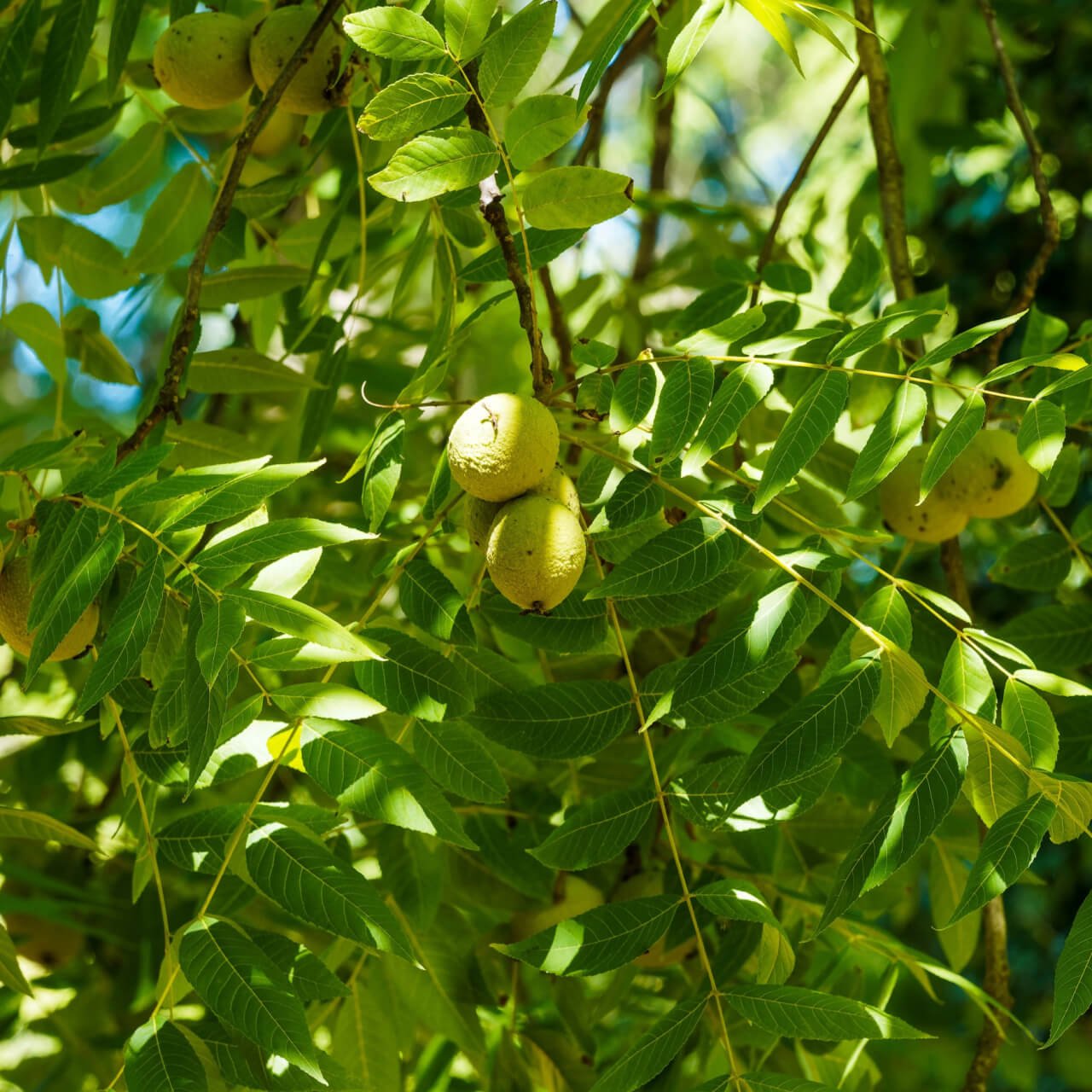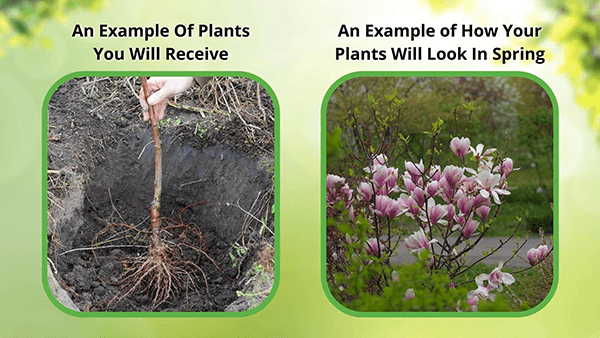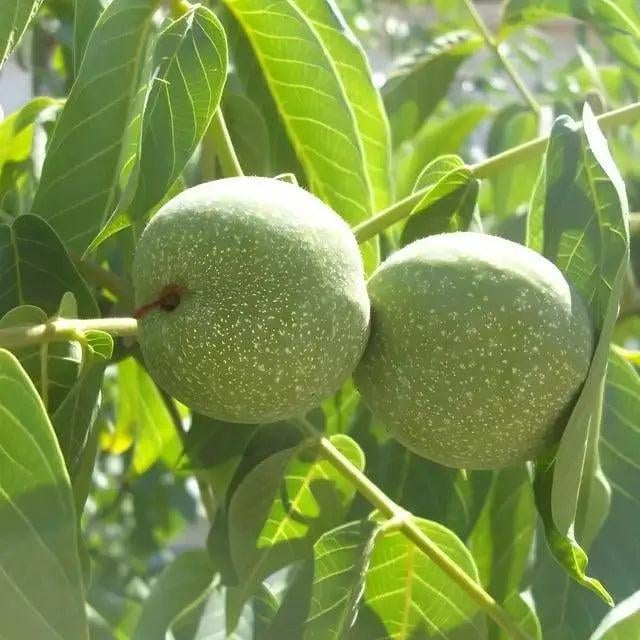




Black Walnut Tree
Shade tree with broad canopy
Attractive foliage enhances landscape appeal
Deep roots stabilize soil effectively
Thrives in
ZONE 4ZONE 5ZONE 6ZONE 7ZONE 8ZONE 9This plant ships:
November 20251 Year Guarantee on all plants
Black Walnut Tree - Juglans nigra
Black Walnut Tree (Juglans nigra) is a native and deciduous tree.
Plant Details - Black Walnut Tree
Family: Juglandaceae
Light Requirement: Full Sun
Water Needs: Moist
Height: 50 – 75 ft.
Spread: 50 – 75 ft.
Growth Rate: Slow
Bloom Time: Spring
Flower Color: Yellow
Wildlife Value: Attracts birds
Landscape Uses and Maintenance - Black Walnut Tree
Black Walnut Tree is a slow growing deciduous tree that will reach great heights and create a large canopy, making a dramatic impact on your landscape.
Plant this tree to create a shade garden with plants tolerant of the Black Walnut. Alternatively, you can plant this tree as an accent in your landscape. Avoid planting this tree along pathways.
This tree has yellow green catkins that emerge in the spring that are wind pollinated. This tree has thick ridged bark.
This tree will produce large nuts that are a favorite food of wildlife, including birds and squirrels. Nuts begin green and turn black as they mature, falling off the tree in early to mid fall. Caution, these nuts are heavy - mind your head!
Its green leaves will turn yellow in the fall. Prune damaged or diseased branches.
Plant this tree in an area that gets full sun and moist, well draining soil. This tree prefers loam or sandy soils. Avoid planting it in clay or compacted soil.
Water this tree thoroughly until well established. Make sure to water this tree during drought, as it prefers moist soil.
This tree is deer resistant.
Generally this tree is resistant to disease, but it should be watched for the Thousand Cankers disease.
Noteworthy Characteristics
You should be mindful of where you plant this tree - the Black Walnut Tree is known for producing a compound called juglone, which goes into the soil around the tree. However, do not be deterred from having a garden under this tree! There are plants that are tolerant of the compound, including ferns, bee balm, and astilbe.
Once mature, the seed husks are used for natural dyeing.
This tree is the host of the Luna Moth and many other butterflies.
This Is How Your Plants Will Look upon Delivery

Height at Maturity
Over 25 Feet
Care
Water Black Walnut trees deeply and infrequently to promote profound root growth. Mulch near the bottom to maintain moisture and regulate soil temperature. Prune during dormancy to remove dead or crossing branches and prevent disease.
Plant Reproduction
Black Walnut spreads via fallen nuts and root sprouts.
Plant bare root trees during the dormant season in early spring or late fall (November through April). Dig the hole twice as wide as the roots so the soil is well-drained. Position the tree so the root flare is at or just above ground level. Fill the hole back with the soil you dug from and water. Maintain soil moisture, especially in the tree's early years, by providing deep, regular watering. Apply a 2-4 inch mulch away from the trunk at the base to retain moisture and suppress weeds. Prune trees during the first few seasons to establish strength and resilience, remove damaged branches, and continue maintenance pruning as the tree matures. Regularly inspect for pests and diseases and apply integrated pest management practices. Protect young trees from mechanical damage and extreme temperatures with tree guards, and stake them if necessary for support, removing the stakes after one or two years.
Shipping date depends on the date displayed and chosen when you order from the product's page.
We only accept returns on plants verified dead. If you think your plants have died, we offer a 1 year warranty, please use this File a Claim Link to verify dead plants and start with return warranty process.






.png?v=1722017930486&em-origin=cdn.accentuate.io&em-format=auto)
Premium Timber:
Black Walnut Trees produce some of the most sought-after hardwoods, perfect for crafting high-quality furniture and cabinetry. Its rich, dark wood adds both beauty and value to any woodworking project.
Delicious Nuts:
Enjoy the rich, flavorful walnuts produced by these trees, ideal for snacking, baking, and culinary dishes. Freshly harvested nuts from your own garden can elevate your recipes and provide a satisfying harvest.
Stunning Foliage:
With its dark green leaves that turn vibrant yellow in the fall, the Black Walnut Tree adds seasonal beauty and visual interest to your landscape. Its impressive canopy provides a striking contrast in any garden setting.
Wildlife Habitat:
Black Walnut Trees attract a variety of wildlife, including birds and small mammals, by providing food and shelter. They help support a healthy, biodiverse garden ecosystem.
Caring Tips
How do I care for my Black Walnut Tree?
Each box contains detailed care instructions and information about your product. But here's the basics.
Care Tips
Water Black Walnut trees deeply and infrequently to promote profound root growth. Mulch near the bottom to maintain moisture and regulate soil temperature. Prune during dormancy to remove dead or crossing branches and prevent disease.
Light Requirements
Black Walnut trees thrive in full sun, requiring at least six hours of direct sunlight daily. They can tolerate partial shade, but total sunlight exposure is ideal for optimal growth and nut production. Ensure they have ample space to grow.
Hardy Planting Zones
4 • 5 • 6 • 7 • 8 • 9
Header
Use this content to share information about your store and products.
Frequently Asked Questions
How often should I water my plants?
How do I know if my plant is getting too much or too little sunlight?
What should I do to prepare my plants for winter?
What are the signs that my plant needs fertilizing?
How can I prevent pests from damaging my plants?
How do I choose the right plant for my climate zone?






